
LSC Redesigns the D-LOK
(Les denne artikkelen på norsk)
Lifesaving Systems has redesigned the double-locking gate for our D-LOK hoist hook in response to customer feedback and issues relating to dynamic rollout and the ever-changing tactics in helicopter rescue and equipment utilized by our customers. To fully understand the reasons behind the design change, a history of the development of the product and helicopter hoist hooks, in general, is in order.
Hook History:
When Lifesaving Systems Corp. founder Sam Maness designed the D-Lok hoist hook in 1995, there wasn’t a customer asking for a better hook. At the time, almost everyone used the standard Mil-Spec hook, with a utility eye and two spring-loaded gates. Dynamic (Ring) Rollout had been a problem for the U.S. Coast Guard and Sam wanted to solve the problem. The Coast Guard handled rollout by aggressively checking the interface of all attaching hardware. By changing the size and shape of all attaching rings they made rollout impossible from the Mil-Spec hook they utilized. But Sam knew then what we keep learning over and over again; you cannot control what someone else puts into a hook. He intended to make a better device and designed the first dual auto-locking hook for helicopters.
The first customer for the D-LOK (Serial # 1) was Australia in 1997. In the over 20 years since, LSC has shipped almost 10,000 D-LOK hooks in different fitment types and they’ve been used in literally millions of helicopter hoists without a single rollout reported. LSC had tested every available ring we could find and couldn’t unlock the gate.
After the D-LOK gained popularity in the late nineties, Aerial designed the Slide-Lok hook and the Coast Guard went with it. I was there when the hook was introduced. What we were told we should like about it was the familiar exposed beak of the hook. Coast Guard Swimmers had grown used to sliding the ring against the gate and catching it in the hook with ease (pinching open the D-LOK gate would have been too much effort?). But the new hook introduced an old problem.
The lifting ring of the LSC litter sling (#190), which was designed by LSC to not roll out of the Mil-Spec Hook could roll out of the Aerial Slide-Lok. The Coast Guard asked LSC to make a custom lifting sling using the same rings as the Tri-Sar and the 193 sling was born to solve that problem.
Dynamic rollout is a hook problem that depends on the geometry of the attaching hardware. Comprehensive testing must be done in order to determine the safety of the hook/ring combination.
The Army Tests:
In 2016, when the U.S. Army also encountered a rollout issue with the Slide-Lok, the Aviation Engineering Directorate headed to LSC to do some testing. (Most of what they put into the hook is made by LSC). They wanted to run a test of all gear hoist and evaluate every available hook on the market for three factors:
Accidental Unlock: Could the locking mechanism of the hook be accidentally unlocked?
Undesirable Position Geometry: Did the size and shape of a ring they used allow it to come into contact with the gate or locking assemblies?
and Susceptibility to Ring Rollout: Could the ring be forced to rollout of the hook?
The U.S. Army did testing with every conceivable ring and piece of kit they used to determine the safety of the available hooks against those three metrics.
The resulting test data is available in the images below: the lower the score the better.
The hooks were then ranked in order for the Army’s purposes. To our surprise, the D-Lok was not in first place. The Lifesaving Systems Mil-Lok was.
- LSC Mil-Lok (4 Points)
- LSC D-Lok (9 Points)
- Aerial A-Lok (11 Points)
- Mil-Spec Hook (18 Points)
- Aerial Slide-Lok (19 Points)
For the U.S. Army’s purposes, as it relates to the rings and attaching hardware they used, they found that the hook they were using was not optimal.
What LSC took away from the testing was that there were things we could improve.
Ring Geometry Strikes Again:
The Army tests were good, but they were for the Army and the gear they used. We conduct similar tests with any hoistable equipment we manufacture. All new designs are tested against the D-LOK, the Mil-LOK, as well as the Mil-Spec and Slide-Lok hooks for susceptibility to rollout. The only ring we manufacture that we know can rollout of a hook is the ring on the 190 Sling and the 402 Vertical Hoisting Sling – which roll out of the aerial Slide-Lok. Both come with a warning not to use the equipment with that particular hook. But as for our D-LOK, our belief was that the design was such that dynamic rollout from the hook was impossible. It wasn’t until March of 2018 that we got word from Australia that they were using a piece of equipment that could essentially defeat the locks on the gate and open the hook.
At the Helicopter Association International (HAI) in Las Vegas, we were shown what happens when you hold the D-LOK just so, and then wrap the SETS Rescue Strop just right around the gate.
Though it requires some fairly specific manipulation, it is possible for the SETS Strop to unlock the gate and “rollout” of a locked D-LOK hoist hook.
To be fair, as the hook was designed, pushing both buttons at the same time unlocks the gate. While strictly not a ring rollout, the unintentional activation of both gate locks by the SETS Ring on one side and the webbing on the other has the same result – the device becomes disconnected from the hook. That’s bad.
Unknown Variables:
The SETS Strop issue in Australia is problematic, but could easily be solved by simply changing the attaching ring used in the manufacture of the strop – and we think they should. But hoist tactics and equipment are changing. We will always be stuck with the first problem of hook design: we cannot control what operators put into the hook. We also cannot control how much they put onto a hook. If one ring can unlock one side of a double-locking gate, what can seven rings do?
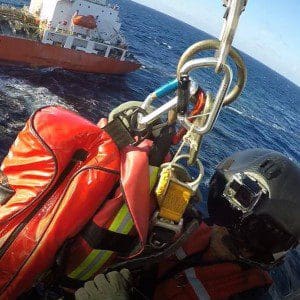
Something else that is happening now that wasn’t seen twenty years ago is the use of single attachment point rings. While they can serve a purpose, in terms of dynamic rollout, they typically just move the problem off the hook and down to the carabiners that are required for use with one of these “Map” or “god” rings. Twenty years ago, there was rarely more than one or two attachments on the hoist hook. Now we routinely see multiple carabiners – of various makes and types – all hanging from the same hook with equipment, rescue personnel, tag lines, medical gear, and victims all being lifted in a single evolution. If these loads, with all the attaching hardware, become unstable, or oscillate, or take a dunk into the water, there would be no telling which forces would act on the gate of the hook and the gate latches.
As unlikely as inadvertently activating the gate latches of the D-LOK may be, due to the SETS Strop reality in Australia (and for all the things we haven’t thought of yet) we redesigned the D-LOK to be even safer. We are not willing to wait and see what else can go wrong.
Redesign
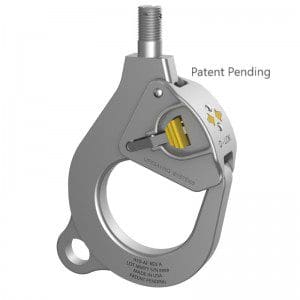
A few weeks ago, we built a prototype of the new design. We performed testing the design against every conceivable ring. Short of welding the gate shut, everything that can be done has been done to prevent inadvertent activation of the latches. LSCs new gate design (patent pending) fully guards the latches on all sides making it impossible for any straight or curved metal ring or any length of webbing or rope to activate an auto-locking gate latch. The gate will always stay double-locked, regardless of the ring used in the hook.
The curve of the gate face and sloping design of the latch guarding keeps any ring, V-Ring, carabiner, etc. from hanging up or becoming jammed on any part of the gate. The gate is still operated easily with one hand and has the same positive locking spring force D-LOK users are used to.
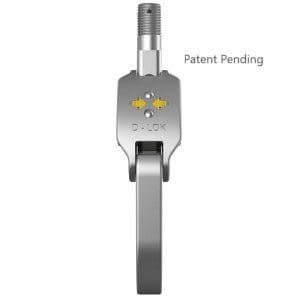
The new gate will be standard equipment on all D-LOK hooks and current hooks can be sent back for retrofitting with the new gate. The tooling for the new design is in production and we expect the first production gates to be available in the next few months. Prototype hooks are being sent to key customers for testing and evaluation in the coming weeks.
Lifesaving Systems will always stay true to the philosophy of our founder, Sam Maness; “The rescuer should have the best possible gear available. If we can’t make it, they should get it somewhere else.” This new design of the D-LOK Gate is better and safer than the previous design. It’s the best possible gear we can make and you should have it.
For questions or comments, email products@Lifesavingsystems.com


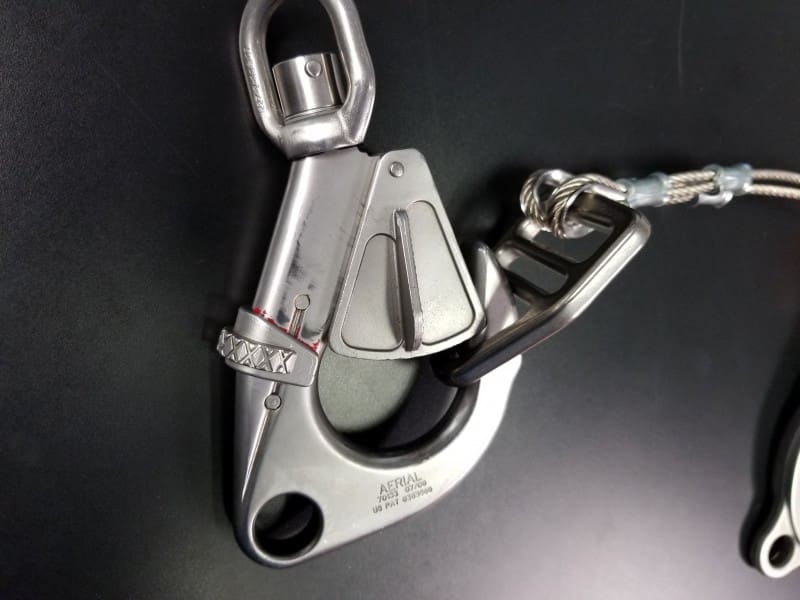
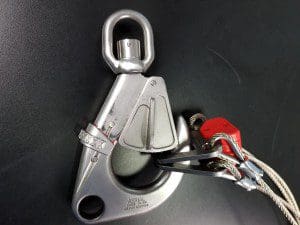



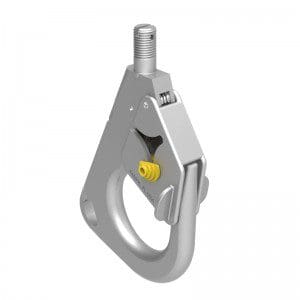
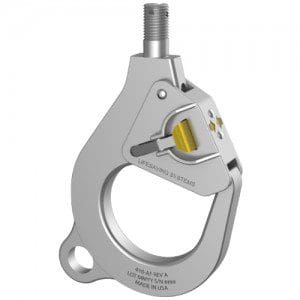

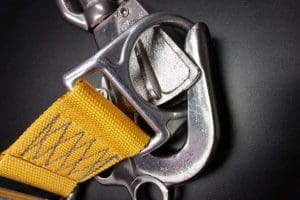

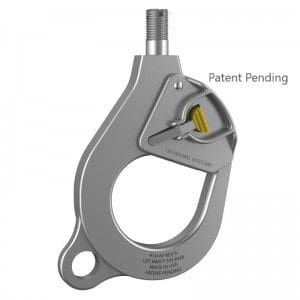

I’m a Field Engineer for a rescue hoist company and work with your hook every day. The D lok hook is by far the best hook in service and it’s the number one choice for our hoists. I lke the idea of the redesign but would like to see bigger and easier to press lock buttons. Having the additional area in front of the button will be safer but will make operation harder. The number one complaint I get from customers is the buttons can be difficult to locate and press in the heat of the moment, especially for guys working in freezing conditions with big gloves. Making the buttons bigger with less force required to depress would make a more user friendly hook.
Andy – I’ve had the prototype in my hands for hours, wearing all kinds of wetsuit gloves and winter flight suit gloves. The gate is actually easier to open by hand than it was previously. However, we should get the new hook into the hands of your customers – we welcome the feedback. Thanks!
Is there any type of documentation or reference that specifically states that there should be only one device, carabiner, bull ring attached to the hook while conducting hoisting operations? If not is it ok to attach multiple devices on the hook at one time? Thanks and any feedback would be greatly appreciated
The D-LOK was specifically designed to allow more than one ring into the hook body. There is no technical guidance from any governing body that states “one ring only” or single attachment point. However, that is a tactic and a policy of many rescue organizations. The hook can accept more than one ring. In the USCG we had a procedure that once used five rings in the hook at once.
Well done! I’ve used this hook operationally for 10 years with over 500 missions and never though what you showed in the video clip could happen. That is true continuous improvement.
I am unclear on your critique of a single point attachment to the rescue D-lock hook. Your suggestion that if a load becomes unstable or begins to oscillate, there is no telling the forces that could be applied is unsubstantiated. As for going in the water, there is no operator I am aware of that uses the map or “god” ring or Forged Steel O-ring ( LSC Catalog part number SKU-363) to hoist to the water. Paramedics and EMTs routinelly have to be hoisted with multiple pieces of equipment and at present the single point attachment is the safest to prevent a roll out condition.
Curtis: In the image above, the rescue is over the water. Entering the water inadvertently is not an impossibility. If your paramedic work takes you down to a boat, you may go into the water, yes? I’m not saying the single point attachment (by itself) is a bad idea, but that twist lock carabiners can roll out as well (they can – we’ve seen it). However, (personally) I believe the safest way to get all that gear down to the scene is to do what every Coast Guard Rescue Swimmer does on every medevac – always – which is go down with some of the gear on his/her equipment hook and if more gear is needed, send it down on a second hoisting evolution. MAP rings are fine, but my comment is not without merit. They solve one problem and create others.
Hi Mario,
I am really impressed with LSC’s attitude to the problem, many people and companies would have just put up their hands and said we can’t prevent every possible occurrence(as true as that statement is). SETS modified the connection point to their rescue strop but you guys kept thinking and pushing your design.
I do find it perplexing that operators have moved the problem else where with carabiners that suffer the same dynamic roll-out or inadvertent opening problem (I wonder in trying to simplify things[single god ring] have we made them more complicated??)… Having said that would there be any merit in creating a smaller version of your D-Loc to replace the carabiners or those double action hooks that are often on wander leads? Winch operators seem to fall out of aircraft more than rescue crew come off the hook……
Bryn:
I am certain you are right – the solving of one problem often causes another. Funny you should mention a smaller D-Lok. You’ll never guess what our next product release is? OK – so you might. We’ve designed a mini-D-Lok for just that reason. There is no such thing as a locking carabiner; but we can make an auto-locking no-roll-out mini-hook. Prototypes are done, testing is underway, we’re excited about the possibilities.
Mario